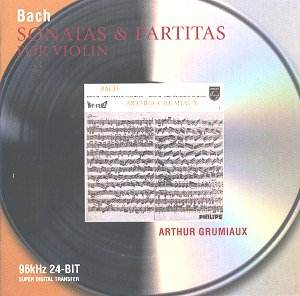JOHANN SEBASTIAN BACH (1685-1750)
Sonatas and Partitas for Violin BWV 1001 - 1006
Sonatas for Violin and Harpsichord BWV 1016 - 1017
Sonata no. 1 in G minor [14.01]
Partita no. 1 in B minor [19.54]
Sonata no. 2 in A minor [19.00]
Partita no. 2 in D minor [24.44]
Sonata no. 3 in C major [20.32]
Partita no. 3 in E major [14.47]
Sonata for violin and harpsichord in E major * [16.51]
Sonata for violin and harpsichord in C minor * [15.21]
 Arthur Grumiaux,
violin
Arthur Grumiaux,
violin
* Egida Giordani Sartori, harpsichord
Rec: Nov. 1960 (BWV 1001, 1006), Feb. 1961 (BWV 1002, 1005), Mar. 1961 (BWV
1003, 1004), June 1963 (BWV 1016, 1017).
 PHILIPS 464 673-2
[146.05]
PHILIPS 464 673-2
[146.05]
Crotchet AmazonUK
AmazonUS
Amazon
recommendations

Bach's sonatas and partitas for solo violin stand apart in the composer's
work, as well as in the entire repertoire of violin music. While other composers
have written solo pieces for violin (some of Bach's predecessors, such as
Biber, Westhoff and Walther had written solo violin works, and others wrote
solo pieces after Bach), none approach Bach's works, which stand at the summit
of the violin repertoire. Written in the middle of Bach's life (completed
in 1720), these six suites achieve the unthinkable - they manage to express
complex polyphonic music with an essentially monophonic instrument. When
listening to them, one is constantly amazed at the unheard harmonies that
are created in the listener's inner ear through Bach's magnificently subtle
counterpoint.
Bach was himself an excellent violinist, in addition to being a virtuoso
organist and harpsichordist, and these works are indeed very difficult, both
in the actual playing as well as the nuances of phrasing that need to be
applied. Many violinists have recorded these pieces, but few stand out like
this landmark recording by Arthur Grumiaux made in the early 1960s. It is
indeed excellent to see that Philips has re-released them in their new 50
Great Recordings series.
It is difficult to describe these pieces - they are miracles of music, where
a single violin embarks on some of the most remarkable musical discourses
ever written. Constructed in the sonata da chiesa form
(slow-fast-slow-fast), the three sonatas each contain fugues as their second
movements. One of Bach's most memorable fugues appears in the first sonata
in G minor; this fugue, originally written for organ, is a masterpiece of
simplicity and complexity combined.
Based on the standard suite of dance movements popular in the Baroque period,
the three partitas vary from 5 to 8 movements. One naturally thinks of the
massive chaconne in the second partita, at over 13 minutes in this recording,
this series of variations on a theme is perhaps the most incredible movement
ever written for the violin.
Grumiaux's interpretation of these works is singular and personal, and, while
some may disagree with his choices of tempo and phrasing, or with his occasional
straying from Bach's manuscript, this remains one of the best recordings
of these works. He shows a unique understanding of this music. While one
may prefer a historically informed performance, such as that of Sigiswald
Kuijken on DHM, or Lucy van Dael on Naxos, it is undeniable that Grumiaux
gives this music the feeling it deserves.
The two "bonus" works on this recording, the two sonatas for violin and
harpsichord, show Grumiaux in a different light. They are less convincing,
in part because of the sound (the instruments are separated too much, with
the harpsichord on the right channel and the violin on the left channel),
and the harpsichord itself, which undoubtedly has the sound that was expected
of the harpsichord in the 1960s. (I can't help but think it sounds like Lurch's
harpsichord on the Addams Family...)
A mention should be made of the sound quality of the recording. One of Philips'
new 96 kHz 24-bit recordings, this indeed has a clean, clear sound, although
there seems to be just a bit too much reverb. Listening both on speakers
and on headphones (Sennheiser HD 580) shows the sound to be excellent. However,
not having the previous release of these works to compare, I cannot really
say whether there is truly a difference. Suffice it to say, in any case,
that the sound here is near perfect.
This classic 1960s recording of what is, arguably, one of Bach's greatest
works is one of the best. The exceptional sound makes this a must-have disc.
Kirk McElhearn

